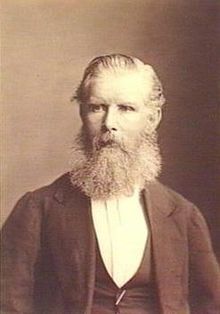John H. Barrow
| John Barrow | |
|---|---|
 |
|
| Treasurer of South Australia | |
|
In office 4 March 1872 – 22 July 1873 |
|
| Premier | Henry Ayers |
| Preceded by | Henry Hughes |
| Succeeded by | Lavington Glyde |
| Member of the South Australian Parliament for East Torrens |
|
|
In office 6 April 1858 – 12 March 1860 Serving with Lavington Glyde |
|
| Preceded by | Charles Bonney |
| Succeeded by | Neville Blyth |
| Member of the South Australian Parliament for The Sturt |
|
|
In office 14 December 1871 – 22 August 1874 Serving with William Townsend |
|
| Preceded by | John Lindsay |
| Succeeded by | William Mair |
| Personal details | |
| Born | 15 February 1819 |
| Died | 13 August 1874 (aged 55) |
| Occupation | Congregational Minister |
John Henry Barrow (1817 – 22 August 1874) was a Congregational minister, journalist and South Australian politician.
Barrow was born in England, son of John Barrow. After he studied for the Congregational ministry at Hackney College, he took charge of the Congregational Church at Market Drayton in Shropshire, where he also ran a school. He was then transferred to Bradford, Yorkshire where he began writing for the Bradford Observer.
Barrow emigrated to Adelaide, South Australia, in the hope that a change of climate would be beneficial to the health of his invalid wife, arriving in September 1853 on the Hannah Maria with his wife and four children, and obtained a position in the office of the South Australian Register. He also did work on the literary side and, when Andrew Garran went to Sydney, succeeded him as principal leader writer. He began preaching to an Independent congregation which met at "Maesbury House", the residence of John Roberts in Kensington, South Australia. The Clayton Chapel (later Clayton Congregational Church) was built for him, but though an excellent preacher, Barrow was unsure whether his real work lay in church life, and he resigned his pastorate in 1858 to enter the South Australian House of Assembly as the member for East Torrens.
...
Wikipedia
